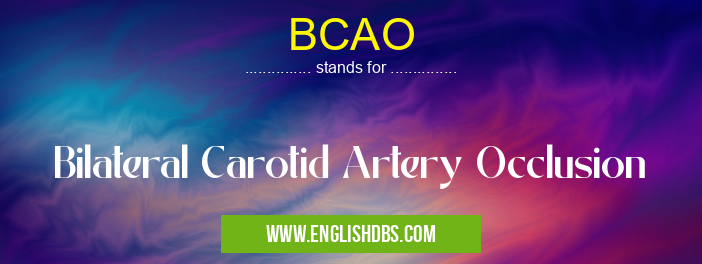What does BCAO mean in UNCLASSIFIED
BCAO stands for Bilateral Carotid Artery Occlusion. It's a condition in which both of the carotid arteries, the main arteries that supply blood to the brain, become blocked. This can lead to a stroke, which occurs when the blood supply to the brain is interrupted.

BCAO meaning in Unclassified in Miscellaneous
BCAO mostly used in an acronym Unclassified in Category Miscellaneous that means Bilateral Carotid Artery Occlusion
Shorthand: BCAO,
Full Form: Bilateral Carotid Artery Occlusion
For more information of "Bilateral Carotid Artery Occlusion", see the section below.
Causes of BCAO
- Atherosclerosis: A buildup of plaque in the carotid arteries.
- Embolism: A blood clot or other material that travels through the bloodstream and blocks the carotid arteries.
- Carotid dissection: A tear in the wall of the carotid artery.
- Radiation therapy: Treatment for cancer in the head or neck area.
Symptoms of BCAO
- Transient ischemic attack (TIA): A temporary interruption of blood flow to the brain, which can cause symptoms such as:
- Weakness or numbness on one side of the body
- Difficulty speaking or understanding speech
- Vision problems in one eye
- Loss of balance or coordination
- Stroke: A permanent interruption of blood flow to the brain, which can cause symptoms such as:
- Sudden weakness or numbness on one side of the body
- Difficulty speaking or understanding speech
- Vision problems in one eye
- Loss of balance or coordination
- Headache
- Confusion
Diagnosis of BCAO
- Physical exam: The doctor will listen for a bruit, an abnormal sound caused by turbulent blood flow in the carotid arteries.
- Carotid ultrasound: A non-invasive test that uses sound waves to create images of the carotid arteries.
- Magnetic resonance angiography (MRA): A non-invasive test that uses magnetic resonance imaging (MRI) to create images of the carotid arteries.
- Computed tomography angiography (CTA): A non-invasive test that uses computed tomography (CT) to create images of the carotid arteries.
Treatment of BCAO
- Medical therapy: Medications to prevent blood clots and lower blood pressure.
- Carotid endarterectomy: Surgery to remove the plaque from the carotid arteries.
- Carotid artery stenting: A procedure to place a stent in the carotid artery to keep it open.
Essential Questions and Answers on Bilateral Carotid Artery Occlusion in "MISCELLANEOUS»UNFILED"
What is Bilateral Carotid Artery Occlusion (BCAO)?
Bilateral Carotid Artery Occlusion (BCAO) is a condition in which both carotid arteries, the main arteries that supply blood to the brain, become blocked.
What causes BCAO?
BCAO can be caused by various factors, including atherosclerosis (plaque buildup in the arteries), embolisms (blood clots that travel to the arteries), and certain medical conditions such as vasculitis (inflammation of the blood vessels) and fibromuscular dysplasia (a narrowing of the arteries).
What are the symptoms of BCAO?
Symptoms of BCAO can include transient ischemic attacks (TIAs), which are temporary interruptions of blood flow to the brain, as well as more severe strokes. TIAs can cause symptoms such as sudden weakness or numbness on one side of the body, difficulty speaking, and vision problems. Strokes caused by BCAO can lead to permanent neurological deficits such as paralysis, speech impairment, and cognitive problems.
How is BCAO diagnosed?
BCAO is typically diagnosed through imaging tests such as carotid duplex ultrasound, computed tomography (CT) angiography, or magnetic resonance angiography (MRA). These tests can assess the carotid arteries and determine the extent of any blockages.
What is the treatment for BCAO?
Treatment for BCAO aims to improve blood flow to the brain and prevent future strokes. Options may include medications such as antiplatelets and anticoagulants, carotid endarterectomy (surgical removal of plaque from the carotid arteries), or stenting (insertion of a small device to keep the arteries open).
What is the prognosis for BCAO?
The prognosis for BCAO depends on the severity of the blockages and the presence of any underlying medical conditions. With prompt treatment, the risk of stroke can be significantly reduced. However, BCAO remains a serious condition that requires ongoing monitoring and management.
Final Words: BCAO is a serious condition that can lead to a stroke. Early diagnosis and treatment are essential to prevent a stroke or minimize its effects.
